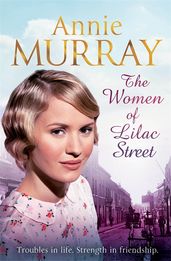Words for Keeping by Annie Murray
Annie Murray shares how a peek into an ancestor's history inspired her book, The Women of Lilac Street.

Just before I started writing The Women of Lilac Street I received a surprise parcel. For many years my half- sister had in her possession a notebook that had belonged to our grandmother, Emmie, and which I had never seen. She had suddenly decided to send it to me.
Its outer cover was a faded, dark red. Down all the pages ran my grandmother's stylish, looped handwriting, so familiar from her letters which used to arrive regularly until she died in 1978. The book was what would be called a Commonplace Book, full of scraps of poetry, wisdom and information that she wanted to record and which she perhaps found a comfort.
Commonplace books first became a fashion in early modern Europe. Quite a few of them still exist and are stuffed full of poems, quotations, letters, recipes and all sorts. Some of them also contain drawings and there are beautiful examples, like the one below, which belonged to a Venetian Merchant in the 14th century.
What I love about Emmie's book is the way long screeds of poetry nudge up against potions to ward off chilblains and other complaints. She was quite a dreamy sort. She had three children and my grandfather ran a Post Office. Amid all the humdrum details of daily life, she evidently liked to have these written things to draw on. I imagine her sitting at the kitchen table and losing herself in one of the poems.
As Emmie was born in 1882, I realised that she may have been copying out the poems she liked at about the same time that the story of The Women of Lilac Street was unfolding; in the mid-1920s. I decided to use a few things from it in the story. One of the main characters, Rose Southgate, who is lonely and unhappily married, pours her inner life into her own commonplace book. Rose also collects pictures in hers, such as the one of Mata-Hari, that the child Aggie becomes so entranced by. Sadly, this was not true of my grandma's book.
It is strange that the word 'commonplace,' which in its archaic use meant something worthy of writing down and quoting, has come to mean something so every day as to be of almost no interest. I suppose I have been keeping my own commonplace books for years, jotting down quotations and poems that I want to keep and which I find helpful or inspiring. Some people – keepers of such books in particular – have always found strength and help in keeping their own chosen selection of the written word. It has been a very nice discovery that my grandmother was also one of them.
The Women of Lilac Street
by Annie Murray
Shortlisted for Historical Romantic Novel in the Romantic Novelists Association Books Awards.
Birmingham, almost a decade after the end of the Great War, and the women of Lilac Street have had more than their fair share of troubles . . .
Rose Southgate is trapped in a loveless marriage. Shy and isolated, she makes the best of life, until she meets a man who changes everything.
Jen Green is struggling to make ends meet, with a sick husband and five children to support. Aggie, her eldest daughter, is twelve years old and longs for excitement. But prying into the adult world shows her more than she had bargained for.
And Phyllis Taylor is a widow who has managed to put a dark and traumatic past behind her. But the return of her daughter Dolly threatens all that . . .
These women find strength in friendship, as they discover that the best way to solve their problems is to face them together, in Annie Murray's compelling The Women of Lilac Street.
